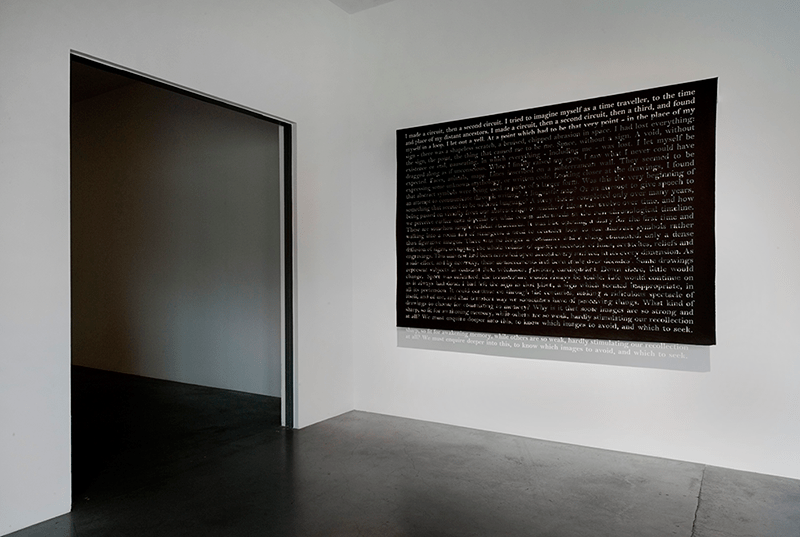Ríndete Lentamente ante la Sensación de Rosa Barba.

Texto recortado en fieltro 70 6/7 x 94 1/2 in. (180 x 240 cm.)

Barba cuidadosamente selecta sus materiales puros, estableciendo elementos físicos e intangibles al servicio de su producción artística. Los elementos del cine son utilizados por Barba como un lenguaje. El proyector lleva el rol dominante en I Made a Circuit, Then a Second Circuit (2010), estableciendo un diálogo entre los lenguajes de la escultura y el cine. La superposición de una secuencia recortada y su proyección resulta en la elegibilidad e ilegibilidad, cuestionando la percepción, interacción y colapso del texto en un infinito.
La obra de Barba utiliza el lenguaje en su sentido más literal. Ella toma las palabras, escritas o leídas, a mano o digitalizadas en una pantalla realizada en materiales naturales. Estos textos fungen como vehículos para crear imágenes. A continuación, se incluye una transcripción del texto que forma parte de I Made a Circuit, Then a Second Circuit (2010), compuesto por la artista misma:
I made a circuit, then a second circuit, I tried to imagine myself as a time traveler, to the time and place of my distant ancestors. I made a circuit, then a second circuit, then a third, and found myself in a loop. I let out a yell. At a point which had to be that very point – in the place of my sign – there was a shapeless scratch, a bruised, chipped, abrasion in space, I had lost everything: the sign, the point, the thing that caused me to be me. Space, without a sign. A void, without existence or end, nauseating, in which everything – including me – was lost. I let myself be dragged along as if unconscious. When I finally raised my eyes, I saw what I never could have expected. Faces, animals, maps, lines, inscribed on a subterranean wall. They seemed to be expressing some unknown mythology, or written code. Looking closer at the drawings, I found that abstract symbols were being used as parts of a larger form. Was this the very beginning of an attempt to communicate through writing? A linguistic map? Or an attempt to give speech to something that seemed to be without language? A story that is completed only over many years being passed on visually from one abstract sign to another? Ideas can evolve over time, and how we perceive earlier ones depends on what comes afterwards in the nonchronological timeline. These are somehow simple cellular structures. It was like opening a diary for the first time and walking into a room full of strangers; a need to consider how to use abstract symbols rather than figurative images. There was no longer a container and a thing contained, only a dense diffusion of signs, occupying the whole volume of space, a network of lines, scratches, reliefs and engravings. This universe had been scrawled upon across every surface, in its every dimension. As a side effect, and by necessity, these measurements had been made over decades. Some drawings represent subjects in constant flux: volcanoes, glaciers, earthquakes. Down there, little would change. Space was unlimited, the temperature would always be stable. Life would continue as it always had done. I had left the sign in that place, a sign which seemed inappropriate, in all its pretension. It could continue on through the centuries, making a ridiculous spectacle of itself, and of me, and that transient way we sometimes have of perceiving things. What kind of drawings to choose for committing to memory? Why is it that some images are so strong and sharp, so fit for awakening memory, while others are so weak, hardly stimulating our recollection at all? We must enquire deeper into this, to know which images to avoid, and which to seek.
En las instalaciones de Barba, el tiempo está intrínsecamente unido a la idea del movimiento. En éstas los proyectores nos refieren al pasado, pero su comportamiento solamente tiene sentido en el presente, cuando los carretes de celuloide transparente se encuentran en movimiento. El sentimiento de tiempo suspendido se mantiene en la ausencia de imágenes fílmicas o fotográficas, o en palabras de Barba, “lentamente nos abandonamos a la sensación”.[1]
Podría parecer superfluo afirmar que la práctica de Rosa Barba se encuentra exclusivamente enfocado con problemas de temporalidad: su principal medio es el filme y sus formas que se relacionan de alguna manera a la práctica cinematográfica, la historia y sus géneros. Sin embargo, este sentido literal no se relaciona con el enfoque de I Made a Circuit, Then a Second Circuit (2010); más bien, la manera en que la temporalidad se encuentra espaciada y visualizada por las diferentes obras, crea un registro múltiple del tiempo y el espacio entre ellas.
Rosa Barba nació en Agrigento en 1972 y creció en Alemania, donde estudió en la Academy of Media Arts en Colonia, seguido por una residencia en Rijksakademie van Beeldende Kunsten en Ámsterdam. Actualmente vive y trabaja en Berlín. Barba ha exhibido extensivamente a nivel internacional, incluyendo exposiciones individuales en el Museo Nazionale delle Arti XXI secolo, Roma (2014), CAC, Center of Contemporary Art, Vilnius (2014), Turner Contemporary en Margate (2013), Cornerhouse en Manchester (2013), MUSAC en Castilla y León (2013), Bergen Kunsthall (2013), Kunsthaus Zúrich (2012), Jeu de Paume, París, (2012), Contemporary Art Museum de St. Louis, Fondazione Galleria Civica, Trient (2011), MART, Rovereto (2011), Kunstverein Braunschweig (2011) y el Tate Modern de Londres (2010). Ha participado en las ediciones 52 y 53 de la Bienal de Venecia y la segunda edición del Thessaloniki Biennial of Contemporary Art (2009), la Bienal de Liverpool (2010), y la Bienal de Sydney (2014).
[1] Cámara, Cristina. “Rosa Barba.” Tate Museum. 2010. Web. 13 Sept. 2016.http://www.tate.org.uk/whats-on/tate-modern/exhibition/level-2-gallery-rosa-barba/rosa-barba-cristina-camara
